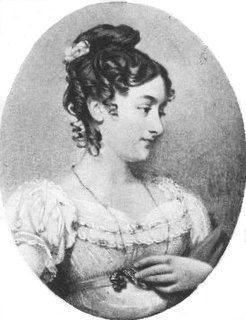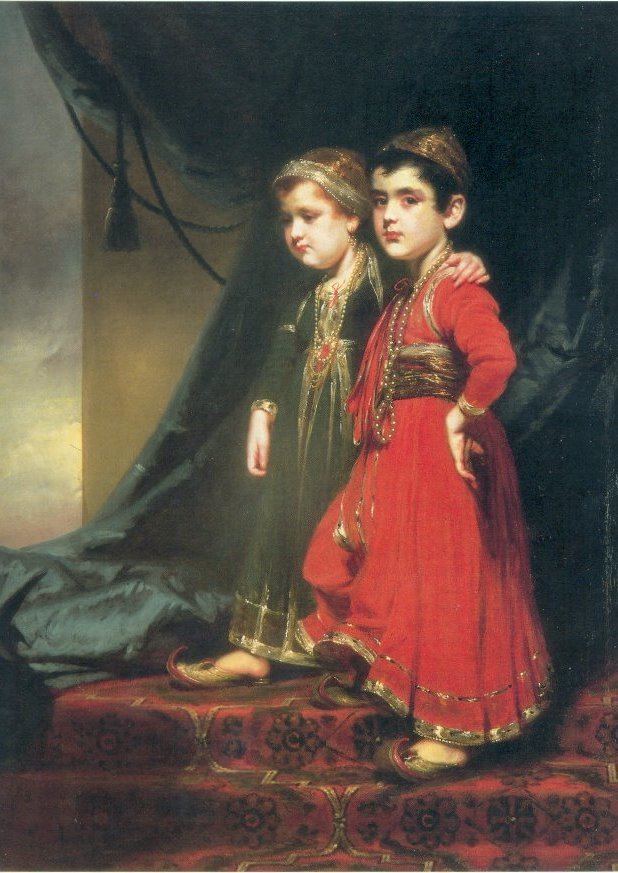Name Kitty Kirkpatrick | ||
 | ||
Parents James Achilles Kirkpatrick | ||
Katherine Aurora "Kitty" Kirkpatrick (9 April 1802 – 2 March 1889) was an Anglo-Indian woman who is best known as an exemplar of the kinds of Indo-British encounters possible during the early years of British colonialism in India, and as a muse of Thomas Carlyle.
Contents

Early life
Kirkpatrick was born in India, the child of James Achilles Kirkpatrick, British Resident in Hyderabad (1798–1805), and Khair-un-Nissa, a Hyderabadi noblewoman. Through her mother, Kirkpatrick was a Sayyida or lineal descendant of the prophet Muhammad. Kirkpatrick was initially named Noor un-Nissa, Sahib Begum ("Little Lady of High Lineage"), and was raised a Shi'a Muslim in the mansion her father built, the British Residency, Hyderabad.
As a result of her father's conversion to Islam and his perceived betrayal of British interests in India, Kirkpatrick and her elder brother Mir Ghulam Ali, Sahib Allum, were taken from their parents when they were about three and five years old respectively. The well-known painter George Chinnery created a portrait of the siblings in Madras in 1805, shortly before they were sent to live with their paternal grandfather, Colonel James Kirkpatrick, in England. Their father died shortly after the children's departure.
The two children were baptised as Christians on 25 March 1805 at St. Mary’s Church, Marylebone Road, and were thereafter known by their new Christian names, William George Kirkpatrick and Katherine Aurora "Kitty" Kirkpatrick. They never again saw India or any members of their maternal family.
Life in England
Both Kirkpatrick and her brother had substantial sums settled on them by their mother, which allowed for them to be raised and educated in middle-class comfort. William Kirkpatrick acquired a disability in 1812, as a severe burn injury resulted in the amputation of one of his arms. He became reclusive thereafter, though he successfully graduated from Oxford University in 1820, married, and had three daughters before his early death in 1828. Her brother's death, as well as that of her grandfather and other relations, left Kitty with a substantial inheritance estimated at about £50,000.
Katherine Kirkpatrick was educated privately, brought up to emulate the ideal of the Christian lady. After the death of her grandfather, Kirkpatrick lived with various of her married cousins: Clementina, Lady Louis; Julia, wife of Edward Strachey; and (Barbara) Isabella, wife of Charles Buller, M.P. Kirkpatrick grew up to be a famous beauty. In 1822, while staying with her Buller cousins, she met the Scottish philosopher and historian, Thomas Carlyle, who was then employed as the Buller children's tutor and who swiftly became infatuated with Kirkpatrick. The romance was encouraged by another of Kitty's cousins, Julia (who married Edward Strachey, grandfather of the writer Lytton Strachey). However, the impoverished Carlyle was not believed by the rest of the family to be a suitable match for the wealthy and well-connected Kirkpatrick. Carlyle would later immortalise Kirkpatrick as the Calypso-like Blumine in his novel Sartor Resartus.
In his memoirs, written many decades later, Carlyle wrote a pen portrait of Kirkpatrick, one which admires her beauty but is clearly suspicious of her mixed-race ancestry:
a strangely complexioned young lady, with soft brown eyes and floods of bronze-red hair, really a pretty-looking, smiling, and amiable though most foreign bit of magnificence and kindly splendour
On 21 November 1829, Kitty married James Winslowe Phillipps (1802-1859), an army officer in the 7th Hussars Regiment, and a member of the Kennaway family, which also had Indian connections. It was evidently a happy marriage. Kirkpatrick and Phillipps went on to have seven children, of whom four survived to adulthood: Mary Augusta (1830-1909), John James (b. 1834), Emily Georgina (b. 1835), and Bertha Elizabeth (1840-1875).
Renewed contact with India
Kirkpatrick's paternal family had long forbidden her from maintaining any contact with her family in India. However, with the help of her father's former assistant, Henry Russell, son of Sir Henry Russell, Kirkpatrick was able to re-establish contact with her maternal grandmother after almost four decades of separation. Although they were never physically re-united, the two women were correspondents on a regular and often emotional basis for six years. Kirkpatrick's letters make it clear that despite leaving India and her mother at such a young age, she still retained vivid memories of it:
I often think of you and remember you and my dear mother. I often dream that I am with you in India and that I see you both in the room you used to sit in. No day of my life has ever passed without my thinking of my dear mother. I can remember the verandah and the place where the tailors worked and a place on the house top where my mother used to let me sit down and slide. When I dream of my mother I am in such joy to have found her again that I awake, or else am pained in finding that she cannot understand the English I speak. I can well recollect her cries when we left her and I can now see the place where she sat when we parted, and her tearing her long hair. What worlds would I give to possess one lock of that beautiful and much loved hair! How dreadful to think that so many, many years have passed when it would have done my heart such good to think that you loved me & when I longed to write to you & tell you these feelings that I was never able to express, a letter which I was sure would have been detained & now how wonderful it is that after 35 years I am able for the first time to hear that you think of me, and love me, and have perhaps wondered why I did not write to you, and that you have thought me cold and insensible to such near dear ties.
Kirkpatrick died at her home, the Villa Sorrento, in Torquay, Devon, in 1889.
